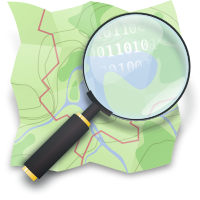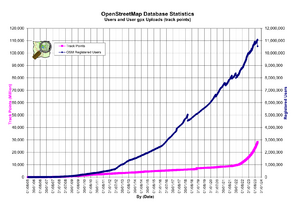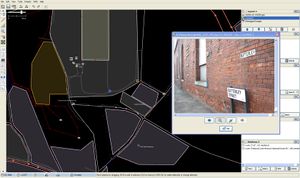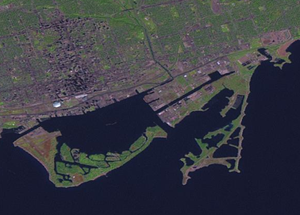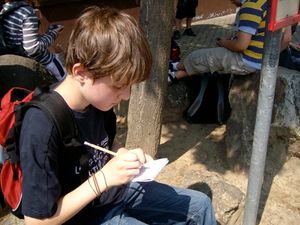Press Kit
Brief facts
- A free street map of the world created by thousands of volunteers, something like Wikipedia.
- A project where everyone can contribute and add objects.
- more than ten million participant accounts with more than 16,000 (and rapidly growing) of those highly active members.
- A worldwide project conducted in multiple languages.
- Anyone can access the OSM map data for free, and it already is being used in many applications.
- There already is full coverage in most urban areas.
- The data can be used in commercial applications.
What is OpenStreetMap ?
OpenStreetMap (OSM) is a project that is building a free map of the whole world. Thousands of members are teamed to create an accurate, detailed and up-to-date map that is as good or better than commercial products. Like Wikipedia OpenStreetMap benefits from the ongoing input of thousands of people around the world.
What is in the maps?
Worldwide, the OSM community collects data about roads, railways, paths, waterways and even bicycle routes. In addition to the transportation ways that are mapped, data is gathered on features along the roads, such as businesses, buildings (private and public), parks and natural areas, land use, cultural resources, and recreational facilities. There are more than 43 categories and hundreds of individual types of data that are gathered. For example, if you need to find a gas station near your location, it likely will be marked on an OSM map.
How is data gathered?
OpenStreetMap data is gathered in several ways. Roads and streets can be mapped by tracing aerial imagery (several organizations provide imagery to OSM) or using GPS units to record a route. In the United States, the extensive road data available from the Census Bureauâ's TIGER database is used as a starting point, though it often requires editing. Also important is the import of data from a wide range of public sources. And, perhaps most important, OSM members either walk or drive a route, recording everything from coffee shops to bus stops to public toilets to add to the maps rich database of information. Further, members don't have to own a GPS unit to participate; they can contribute just by correcting a street name or adding a school right in their own neighborhood. Besides being comprehensive, the data of OSM maps also is of high quality. On other maps, roads may not be precisely aligned, trails may missing and important features can be ignored. Further, other maps can include nonexistent 'trap streets' to catch illicit copiers. However, at OSM data is reviewed and corrected by dozens of contributors, especially data from urban areas, and they are free to fix any errors they find.
Why do we emphasize that OSM is free?
There are a lot of free maps on the Internet, but they are only free to view, not to use the data for an application, such as your own web page. By contrast, OpenStreetMap makes it possible to use freely the map and all its data. The data is released under a free license (Open Data Commons Open Database License 1.0).
Why do people join OSM?
OpenStreetMap is a project in which everyone can participate and enter map information. More than that, those who are technically skilled can write or improve the OpenStreetMap software and extend the documentation. Others can work to help organize the project in many local areas worldwide or to publicize OSM in their area. Most important, for many, are the mapping parties in dozens of local areas worldwide where members gather data, upload it to the map and then socialize. Some say their biggest motivation is that they can see the map growing daily, while others freely admit that they find mapping happily addictive. Whatever their motivation, members are absolutely clear, that OSM is just plain fun.
See also: Getting Involved
Growth
The OpenStreetMap community grows by about 10% per month. At the beginning of 2008 OSM had 20,000 members, but in December 2008 OSM already had 80,000. The level of 200,000 volunteers was reached in January 2010, 500,000 in November 2011, 1,000,000 in December 2012, and currently there are more than ten million registered users.[1] As with any online community, only a small proportion of registered users go as far as contributing, but the project sees many thousands of active contributors in any given week. Germany and the United Kingdom are the countries with the largest local communities, but there are local user groups around the globe. Participation in the United States is growing rapidly, and a formal U.S. Chapter was founded in 2010.
See also: Local OSM usergroups
Coverage
<ADAPT TO YOUR COUNTRY OR THE WORLD> Generally countries in Europe and North America already have quite good coverage. All bigger cities tend to be mapped nearly completely. In the countryside at least the most important roads are mapped as well. In stark contrast to other maps on the Internet, hiking trails, tracks and cycleways are available. Commercial maps are usually created for drivers and so take no account of these features.
As our community grows, we fix blank areas on the map, filling in new roads and areas. If you see something missing you can't hang around for long. Visit the map again in a few months and it might be completely mapped.
In a global comparison, Germany is one of the best covered countries in OpenStreetMap, although the project started in the UK and even here there weren't any big donated imports like in the Netherlands or in the US. If you take a closer look on the map, you will see that this is a worldwide project and there is almost nowhere where no people are working on completing the map.
But as OpenStreetMap is an open system, the map can never be 'complete'. Even if in the first stages, the highways, 'all roads that have names' and 'all roads' have been completed, the level of detail progress. People adding information on buildings, points of interest and improve existing objects. Even the road network isn't static but changes continuously. There is always plenty to do.
up to date
New entries or changes appear within minutes on the map. The possible speed of this update process makes OSM much better to all other competitors. So new buildings, constructions, blocked roads etc. can be immediately visualized. NGOs use OpenStreetMap in areas that were hit by disasters to plan their arrivals after earthquakes, burning forests, landslips or other cataclysm. We support them via the Humanitarian OSM Team.
How does OpenStreetMap work?
From a walk towards a complete map
In areas that have no data in the OSM database, you create a skeleton of roads etc. With a GPS unit, you walk or drive along a way within the area, while the device logs your position. A bicycle is very useful, for residential areas as well as within the woods. The mappers take notes of road names, public telephones, playgrounds and so on. Tools are classic pen&paper but also Dictaphone, digicams etc. Everybody has their own favorite.
See also: [1]
The recorded track is now in the storage of the device. This raw data can already be uploaded to the project, but we don't recover roads and ways back automatically! We have to do this step manually (called mapping). Most people use our tools JOSM or iD. This plotting along the track remembers somewhat like 'paint by numbers', as you know it from paint books. Here we simplify the track (a straight road can be recorded as jittered line due GPS precision limits or if you change the side of the road). So we do a abstraction.
Now the road is a bunch of lines (vectors). You can add tags to it. First its name is important, so you add a tag that represents it: (name=Royal Avenue). Further features are for example the class of the road, is there a cycle lane or is it one-way? The repository of already used map features/tags is really huge. But you will remember the most important ones, after a little bit of training. The editors support you by offering presets, that lookup the right strings..
See also: Map_Features
The freshly designed data can now be uploaded to the project and become immediately accessible for everyone. Now others can view, correct and improve. Step by step this data becomes more and more precise and you can see the map growing, that motivates you to take part in this process..
Data vs. Map
To be honest, OpenStreetMap is neither a map or a city plan, but a database. There we store all the individual objects of the map. You can do whatever you want as long as you respect the license. But as it's not that simple to create maps out the data by end users, the project (so volunteers again) create these maps for you. This step is called 'rendering' The top maps are Mapnik and Osmarender as well as OpenCycleMap. There are also hike- and bike-maps available. But there are so many more and every day you'll get some new ones.
See also: Applications of OpenStreetMap
Also anyone can create for themselves a map according to their own wishes. No matter whether only rivers and lakes are shown (as anm angling map), a railway map is desired (for train lovers), or food shops are to be prominent. However different the maps may look then, they are based on the same base information, differing in which features are displayed.
Further applications going beyond making maps are also possible. An on-line routing service already exists for example that works wholly with OpenStreetMap data. Also the data can be converted in such a way that you can load it into personal navigation devices. Besides ever more specialised GIS programs support the OpenStreetMap format. Since it is the first time the fact that a so large geographical data base is available to everyone it is not yet able to be assessed which further areas of application will open themselves.
Alternative data sources
The basis of OpenStreetMap is the great number of helpful users who explore the country with their GPS units, to complete the map. But a lot of work can be done even without GPS. Everybody knows the street names in their neighborhood, where the next bakery is located, how to find the next post box and so on. Exactly such useful information can be drawn onto the map to improve it. (Reporting bugs)
There is however also still further information that is of use in OpenStreetMap and that allows people to take part without GPS equipment. Satellite photographs are usually protected by copyright and thus unavailable for use in OSM. However there are companies, institutions and private individuals who cooperate with OpenStreetMap by releasing photographss, mapping information, street maps and more that can be used in OpenStreetMap.
So we can use the satellite imagery by Yahoo and since a recently by Microsoft (Bing-Maps) for OSM. So we can provide a nearly global coverage of a lot of details, starting with rivers, forests and lakes, to roads, power lines and even buildings. More detailed are the high resolution orthographic photos (digital ortho photos (DOP)) by the Bavarian State Office for Survey and Geoinformation, that can be used during a pilot project and show how useful this can be for creating a free map. We hope that this will be a good example for public public partnership and that further examples will follow in future. Even in France, we got the permission to use all online published cadastre data as starting point for OSM. Even commercial providers as Aero-West offer us photo material for free..
Sometimes this external information can be imported directly, instead of tracing them. These imports are something special for OSM. During this processing we add high value and complex map informations directly to our database. This not always easy on the technical level, but can improve the quality of an area immediately. Some examples:
- Import of US-public domain TIGER data
- Company AND Automotive Navigation Data with data for the Netherlands and parts of China and india .
- Import of German boundaries by Infas-Geodaten
- Import in Austria by "plan.at"
See also: Import/Catalogue, Potential Datasources
With these multiple sources, that support the survey with GPS, OpenStreetMap has achieved an impressive quality already. Upcoming data donations will certainly increase them, too.
One Database, thousands of maps, infinite possibilities
Because we offer the raw geodata, commercial providers take an interest in OSM. This isn't prohibited by our license: only the data has to stay under the free license. A number of companies provide commercial services based on OSM data, including online maps and mobile routing apps.
See also: OSM Internet Links, and List of Companies offering OSM Consulting
Our data makes applications possible, that no commercial provider can offer, because the cost of proprietary data collection would be prohibitive. For example, Wheelchair-Routing and HaptoRender.
Interesting
Prominent Users
And what does the state offices when they like to publish some positions on a 'open' base? Right! They use our maps: http://www.prtr.bund.de
The White House uses OpenStreetMap data, and Bundesverfassungsgericht Germany. So does foursquare and USA Today.
See also: OSM Internet Links
OpenStreetMap back in school
Working on OpenStreetMap can be part of the school education as lessons or as a project. Topics of course like Geography, Mathematics and Informatics can be taught in the daily environment of the pupils. In the past some projects of this kind already took place. Often they created a map of a town or suburb. Mostly the idea was that fascinating to pupils, that some become active for OSM in their spare time, too:
- Geomatik-Projekt 2008 in Borgholzhausen (Teutoburger Wald)
- Elisabeth-von-Thüringen-Gymnasium Köln
- Anne-Frank-Realschule Montabaur - Rheinland Pfalz
- Mapping Projekt am Richard-Wossidlo-Gymnasium und Vogelpark Marlow in M-V
- MapYourWorld - Schweiz
OpenStreetMap supports such kind of projects. Thanks to a donation, we can offer GPS units for free: [2] Often one or two of our mappers support such actions of schools. But even without, it's easy enough for teachers to understand the project within a few days.
See also Education
Humanitarian Openstreetmap Team
As the earthquake hit Haiti we extracted masses data of aerial imagery for the first time, to support the rescue squads on the ground.
Since this time, the HOT tries after each disaster to get sponsors of imagery and to update our map for the place.
Impressive examples
- Berliner Zoo
- Bikemap
- Routing-Service for pedestrians and cyclists
- OpenSeaMap - the free nautical chart
- local maps and examples? Get in Contact
Numbers, dates, facts
- Founded by Steve Coast (London) in July 2004
- Real start of bigger survey in March 2006
- more than ten million volunteers work worldwide (10% increase per month by March 2015)
- ~ 33 Million kilometres road network (May 2009)
- ~ 250 000 towns/villages/places in Europe
- > 5 billion nodes
- ...
See also: Statistics
